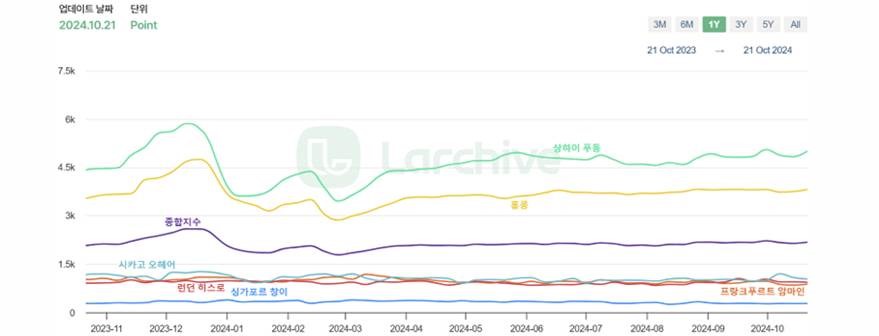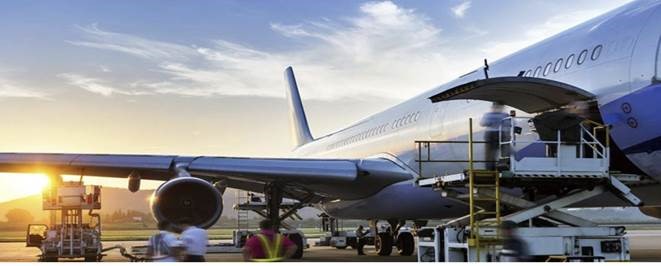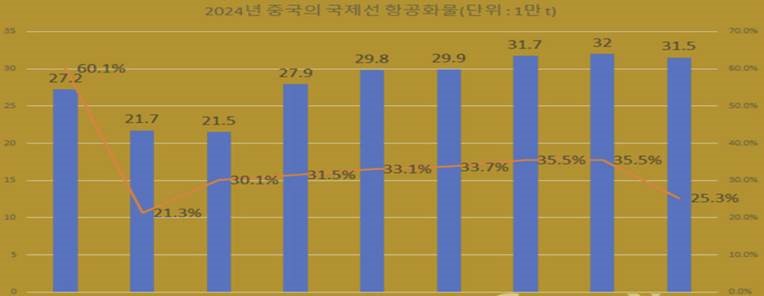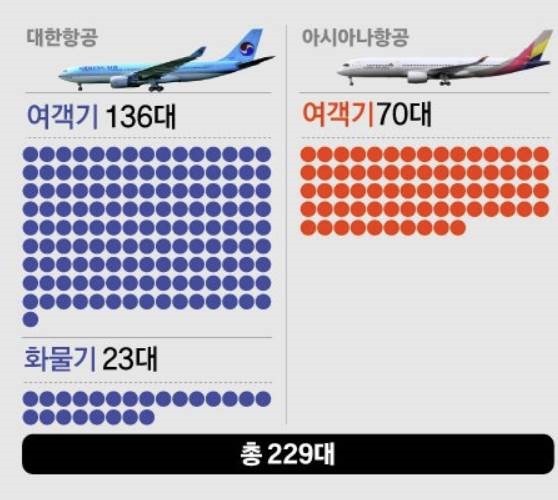- Company
-
Specialized Products
Warehousing Solution
Specialized Freight Solutions
Multimodal Freight Solutions
GSA, CSA & SC
E-Commerce
- Service
- Blog
- Cargo Tracking
- Contact Us
- Site Map

The Power of Logistics to Move the World!
It's the Power of extrans.
EXTRANS GLOBAL - Air Freight News - Week 44 2024
1) Changes in Air Cargo Supply from China to Europe
◇ Baltic Air Freight Rate Index Week 42

-
All routes from China to Europe and the United States have seen an increase in rates, leading the overall rise once again. The outbound route index from Hong Kong rose by 1.6% compared to the previous week, recording a 7.0% increase year-on-year. The outbound index from Shanghai also showed an upward trend on most major routes, increasing by 3.6% from the previous week to reach 5,006 points, with a year-on-year increase of 12.6%.
-
Meanwhile, the market from South Korea is expected to see a significant rise starting from the last week of October, similar to the global market, where contracts for regular charter flights have increased. However, the relatively oversupplied situation remains a variable factor.
-
Recent changes in the air cargo market are anticipated as European airlines withdraw from the Chinese market or suspend route operations.
-
Scandinavian airline SAS and Polish airline LOT have both decided to suspend operations on the Copenhagen-Shanghai and Warsaw-Beijing routes, respectively. Finnair, British Airways, and Virgin Atlantic have also withdrawn from or postponed operations on Chinese routes. The main reason for these changes is the closure of Russian airspace due to the Russia-Ukraine war, forcing European airlines to choose longer detours, which increases costs and flight times.
-
In contrast, Chinese airlines can utilize Russian airspace, maintaining shorter and more economical routes to Europe. This places European airlines at a competitive disadvantage and has direct and indirect effects on the air cargo transport market connecting Europe and China.
-
According to EU statistics, China is the EU's second-largest trading partner, with trade volume reaching 739 billion euros in 2023, resulting in sustained high demand for air transport. European airlines have played a significant role in transporting e-commerce goods between Europe and China through passenger belly cargo. However, if these airlines continue to withdraw from Chinese routes, it is expected to severely impact cargo supply capacity.
2) An increase in consumer spending is expected in the U.S. at year-end, but there are concerns about delays in air cargo exports to the U.S.

-
A representative from Cathay Pacific, which holds the largest share of air cargo transport from China to the U.S., stated, “Demand for e-commerce, high-tech, and electronic products is expected to be strong from mainland China, Southeast Asia, and India,” adding that there will also be an increased demand for fresh food exports from the South Pacific and the Americas.
-
In fact, Cathay Pacific recorded significant growth in performance through the third quarter up to September, with an increase in the transportation of fresh food from the South Pacific, Southeast Asia, and North America to Hong Kong and mainland China. Due to the surging demand for e-commerce, export volumes from the Guangdong-Hong Kong-Macao Greater Bay Area to the U.S. have risen sharply.
-
Concerns are growing that air cargo exports to the U.S. may be delayed ahead of the year-end peak season. The Federal Aviation Administration (FAA) recently advised airlines to strengthen procedures to address safety issues arising from the surge in electronic product deliveries during the year-end, leading to analyses that temporary delays could occur in air cargo transport.
-
The FAA expects an increase in shipments that include electronic products, battery-powered devices, and flammable materials, warning that this could heighten the risks of smoke, odors, and fire on board aircraft. Accordingly, airlines have been instructed to thoroughly reassess the risk evaluation of cargo and strengthen the safety response capabilities of their crews.
-
In particular, the U.S. Customs and Border Protection (CBP) announced that starting November 12, it will refuse entry to exports with unclear cargo descriptions. In practice, using vague descriptions like “gifts” could make it difficult for those shipments to enter the U.S. This measure is aimed at enhancing safety management, and stricter customs procedures are expected in the future.
-
This action could particularly impact exporting companies from China and South Korea that plan to export electronic products and other consumer goods during the year-end peak season. Many companies concentrate their shipments during this period, so there is a possibility of logistics delays due to the enhanced procedures and regulations.
-
Therefore, companies preparing for air cargo exports to the U.S. during the year-end season are expected to carefully review the new regulations and procedures from the FAA and CBP and prepare corresponding countermeasures.
3) Chinese Air Cargo Sets New High for Four Consecutive Months: Strong Demand for Sea & Air

- In September, air cargo (including mail) from Chinese airlines surpassed 800,000 tons, setting a new high for four consecutive months.
- In particular, international flights accounted for 315,000 tons, representing a 25.3% increase compared to the same period last year, leading the overall upward trend.
- Consequently, the rise in international air cargo demand in China has led to an increase in Sea & Air combined transport volumes to our country.
- Domestic air cargo in China also rose to 484,000 tons in September, a 7.5% increase.
- According to the Civil Aviation Administration of China (CAAC), the total air cargo from January to September reached 6.489 million tons, an increase of 24.4% compared to the previous year.
- International flights accounted for 2.603 million tons, a 32.8% increase, while domestic flights also increased by 19.4% to 2.887 million tons.
4) Korean Air and Asiana Merger: 90% Complete


-
"We are all in. Whatever we have to give up, we will make the merger happen." In June, Korean Air Chairman Cho Won-tae made this remark about the merger with Asiana Airlines in an interview with Bloomberg TV. This is the first merger between airlines in the relatively short history of the domestic aviation industry. For Chairman Cho (pictured), who is promoting the merger, it means forging a path that no one has taken before. To overcome criticism that the decision to acquire Asiana Airlines was made in exchange for securing friendly shares (10.58%) from the Korea Development Bank during the management dispute in 2020, the period after the merger will be more important than the merger itself.
-
If T’way Air operates the Frankfurt route in Germany stably for about a month, the European Commission (EC) is expected to finalize its approval of the merger between Korean Air and Asiana Airlines by early November at the latest. If the U.S. Department of Justice (DOJ) does not proceed with antitrust litigation regarding the merger, the merger will be completed approximately four years after Korean Air's decision to acquire Asiana Airlines on November 16, 2020.
-
After the merger, Korean Air will become a mega carrier with over 200 aircraft. Particularly, amid a global shortage of new aircraft supply, Korean Air is expected to immediately benefit from the merger by utilizing Asiana Airlines' aircraft. Specifically, Korean Air is in the process of replacing its long-haul fleet primarily with Airbus A350 and Boeing 787 aircraft, while Asiana Airlines has already introduced the Airbus A350 as the first in the country and is currently operating it as its primary long-haul aircraft. Through the merger, Korean Air will have the opportunity to operate the A350 in advance via Asiana Airlines. Additionally, with more excess aircraft post-merger, it is anticipated that they will be able to return or sell older and more costly leased aircraft, thereby increasing operational efficiency.
-
However, the costs associated with the merger are not insignificant. Firstly, there is a high possibility that Korean Air will face increased short-term financial burdens. The most urgent task is to reduce Asiana Airlines' debt ratio. At the end of last year, the debt ratio was in the 1400% range, but as of June, it had surged to 2952%, nearing 3000%. The increase in debt is attributed to asset-backed securities (ABS) issuance and increased advances, while cumulative losses have decreased capital. For this reason, it is likely that Korean Air will participate in Asiana Airlines' capital increase at the end of this year to lower its debt ratio.
5) Airline/GSA Movement
• Air Canada (AC) plans to switch from GSA sales to an ON STAFF system for cargo sales starting with the winter schedule, selling directly from headquarters.
• Air Premia (YP) will operate its ICN-BCN passenger flights only until November and plans to suspend them. The focus will shift towards the Americas with the launch of European passenger flights to SFO.
• T'way (TW) is expected to receive support from Korean Air (KE) for 2 B777-300ER aircraft, including crew and maintenance staff. After delivery in April next year, the aircraft will operate domestic flights before being deployed on European routes starting in May.

top


